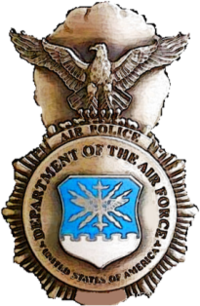
A slouch hat is a wide-brimmed felt or cloth hat most commonly worn as part of a military uniform, often, although not always, with a chinstrap. It has been worn by military personnel from many different nations including Australia, Ireland, the United Kingdom, Canada, India, New Zealand, Southern Rhodesia, France, the United States, the Confederate States, Germany and many others. Australia and New Zealand have had various models of slouch hat as standard issue headwear since the late Victorian period.
The United States Air Force officer rank insignia in use today.

A cap badge, also known as head badge or hat badge, is a badge worn on uniform headgear and distinguishes the wearer's nationality and/or organisation. The wearing of cap badges is a convention commonly found among military and police forces, as well as uniformed civilian groups such as the Boy Scouts, civil defence organisations, ambulance services, customs services, fire services etc.

The Air Force Commander's Insignia is an insignia of the United States Air Force and United States Space Force, that has been in existence since 2002. Also known as the USAF Commander's Badge, the Air Force Commander's Insignia is awarded to any Air Force officer who holds an established command billet within the United States Air Force.

A brassard or armlet is an armband or piece of cloth or other material worn around the upper arm; the term typically refers to an item of uniform worn as part of military uniform or by police or other uniformed persons. Unit, role, rank badges or other insignia are carried on it instead of being stitched into the actual clothing. The brassard, when spread out, may be roughly rectangular in shape, where it is worn merely around the arm; it may also be a roughly triangular shape, in which case the brassard is also attached to a shoulder strap. The term is originally French, deriving from bras meaning "arm".
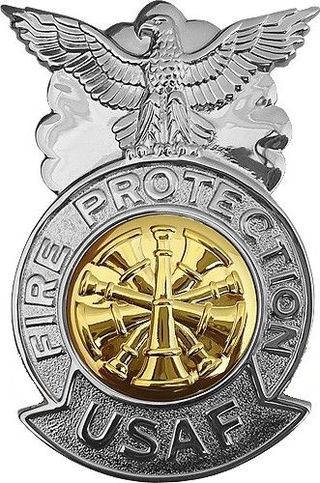
The Air Force Fire Protection Badge is a military badge of the United States Air Force that is issued to those service members who have been trained in safety and fire prevention, have qualified as military firefighters, and have been assigned to an Air Force fire department.

Insignias and badges of the United States Navy are military badges issued by the United States Department of the Navy to naval service members who achieve certain qualifications and accomplishments while serving on both active and reserve duty in the United States Navy. Most naval aviation insignia are also permitted for wear on uniforms of the United States Marine Corps.

The peaked cap, peaked hat, service cap, barracks cover or combination cap is a form of headgear worn by the armed forces of many nations, as well as many uniformed civilian organisations such as law enforcement agencies and fire departments. It derives its name from its short visor, or peak, which was historically made of polished leather but increasingly is made of a cheaper synthetic substitute.

An aiguillette, also spelled aguillette, aiglet or aglet, is a cord with metal tips or lace tags, or the decorative tip itself.
Forage cap is the designation given to various types of military undress, fatigue or working headwear. These vary widely in form, according to country or period. The coloured peaked cap worn by the modern British Army for parade and other dress occasions is still officially designated as a forage cap.
The uniforms of the Canadian Armed Forces are the official dress worn by members of Canada's military while on duty.

The Airman Battle Uniform (ABU) is a U.S. camouflage combat uniform formerly worn by members of the United States Air Force, United States Space Force, and some civilian employees of the U.S. Department of the Air Force until April 2021. It replaced the Battle Dress Uniform and Desert Camouflage Uniform on 1 November 2011 after a four-year phase-in period.

The President's Hundred Tab/Brassard is a badge awarded by the Civilian Marksmanship Program (CMP) to the 100 top-scoring military and civilian shooters in the President's Pistol and President's Rifle Matches. The tab is authorized for wear on military uniforms of the U.S. Army, U.S. Air Force, and U.S. Coast Guard. The brassard version is authorized for wear on enlisted uniforms of the U.S. Navy. The tab is 4+1⁄4 inches (11 cm) long and 5⁄8 inch (1.6 cm) high, with the word "PRESIDENT'S HUNDRED" centered in 1⁄4 inch (0.64 cm) tall letters. The Army's and Air Force's miniature metal replica of the tab is a full-color variant of the tab once authorized for wear on the old Army Green Service Uniform and is about 2 inches (5.1 cm) in width. The brassard is a 3+1⁄2 inches (8.9 cm) long by 1 inch (2.5 cm) high curved bronze metallic arm patch with an enameled representation of the flag of the president of the United States flanked by the seal of the president of the United States to the left and the seal of the CMP to the right. At the top of the brassard are the raised words “PRESIDENT’S” to the left and “HUNDRED” to the right.

Gorget patches are an insignia in the form of paired patches of cloth or metal on the collar of a uniform (gorget), used in the military and civil service in some countries. Collar tabs sign the military rank, the rank of civil service, the military unit, the office (department) or the branch of the armed forces and the arm of service.
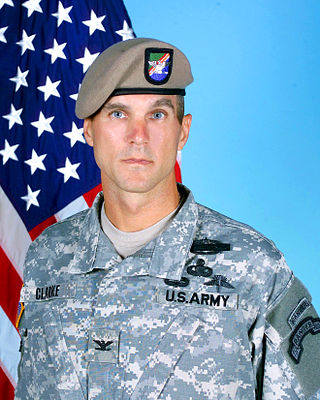
The tan beret, also known as a beige beret, has been adopted as official headgear by several special operations forces as a symbol of their unique capabilities.

The Royal Air Force uniform is the standardised military dress worn by members of the Royal Air Force. The predominant colours of Royal Air Force uniforms are blue-grey and Wedgwood blue. Many Commonwealth air forces' uniforms are also based on the RAF pattern, but with nationality shoulder flashes. The Royal Air Force Air Cadets wear similar uniforms.

The uniforms of the United States Air Force are the standardized military uniforms worn by airmen of the United States Air Force to distinguish themselves from the other services.

Troops began wearing berets as a part of the headgear of military uniforms in some European countries during the 19th century; since the mid-20th century, they have become a component of the uniforms of many armed forces throughout the world. Military berets are usually pushed to the right to free the shoulder that bears the rifle on most soldiers, but the armies of some countries, mostly within Europe, South America, and Asia, have influenced the push to the left.
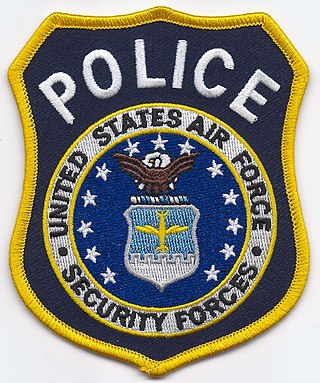
The United States Department of the Air Force Police are the civilian uniformed police service of the United States Department of the Air Force, responsible for the force protection of assets and all aspects of law enforcement on U.S. Air Force and U.S. Space Force installations, and other facilities operated by Air Force and Space Force.
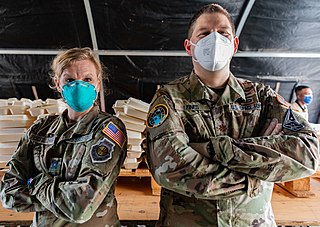
The uniforms of the United States Space Force are the standardized military uniforms worn by U.S. Space Force personnel, known as guardians.

